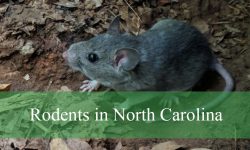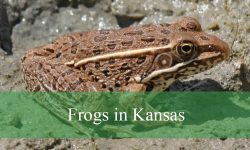Michigan offers birdwatchers a wonderful variety of blue birds that brighten forests, fields, and wetlands across the state. From the vibrant Eastern Bluebird to the sleek Tree Swallow, these species bring color and life to natural habitats.
Each bird has unique features and behaviors, making identification an enjoyable challenge for both beginners and seasoned birders. Knowing what to look for helps you spot these striking birds more easily.
In this guide, we’ll explore 16 blue bird species commonly seen in Michigan, complete with pictures and identification tips. Whether you’re exploring local parks or your own backyard, these birds are sure to impress.
Common Blue Birds You Can See in Michigan
Mountain Bluebird
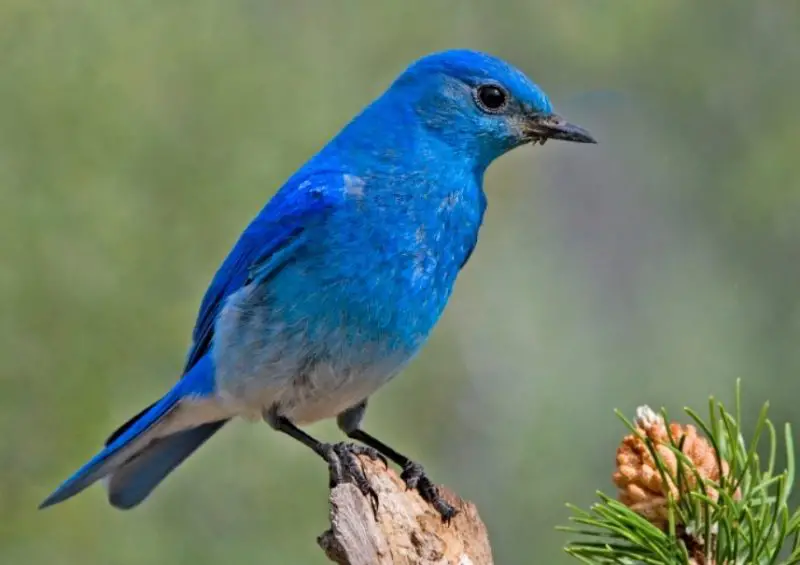
The Mountain Bluebird is a stunning bird with bright sky-blue plumage that covers the entire body of the male, while females have softer grayish-blue tones. It is a species often spotted in open landscapes such as meadows and high plains, including parts of western Michigan.
Males display an intense, almost glowing blue color that stands out against the open habitats they favor. They are medium-sized, about 7 inches (18 cm) long, with a slender body and slightly rounded wings. Females tend to be more muted but still carry a hint of blue.
In Michigan, Mountain Bluebirds are more common in the western and northern regions during the breeding season. They nest in natural cavities or nest boxes and primarily feed on insects and berries. Their cheerful presence and bright coloration make them a favorite for bird enthusiasts.
Eastern Bluebird
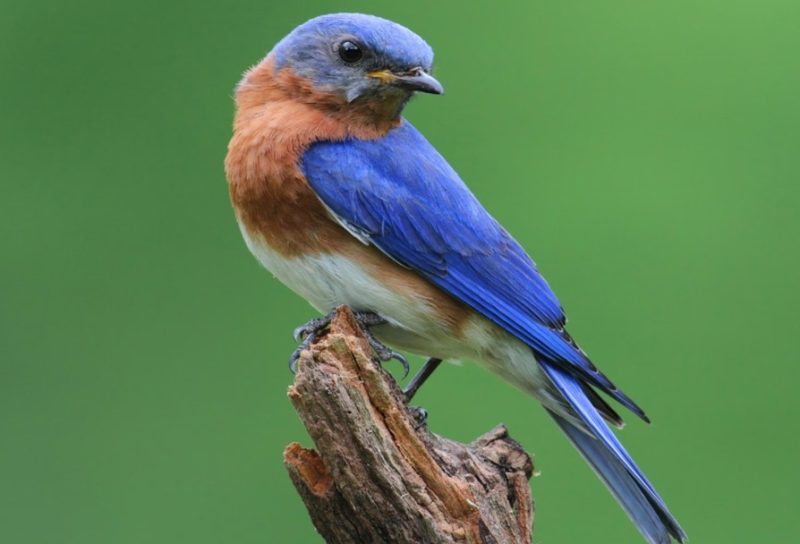
The Eastern Bluebird is a small bird known for its vibrant blue upperparts and warm reddish-orange chest. It is commonly found in open fields, gardens, and parks throughout Michigan, especially during the spring and summer breeding seasons. Its soft, melodious song makes it a favorite among birdwatchers.
Identification is straightforward thanks to its striking color combination. Males display brighter and more vivid blue feathers, while females have duller blue tones and a grayer head. They measure about 6.3 to 8.3 inches (16–21 cm) in length with broad wings that allow for agile flight.
In Michigan, Eastern Bluebirds prefer habitats with scattered trees, open spaces, and plenty of insects for food. They readily nest in natural cavities or birdhouses and play an important role in controlling insect populations. These birds are commonly seen in both urban and rural areas across the state.
Blue Jay
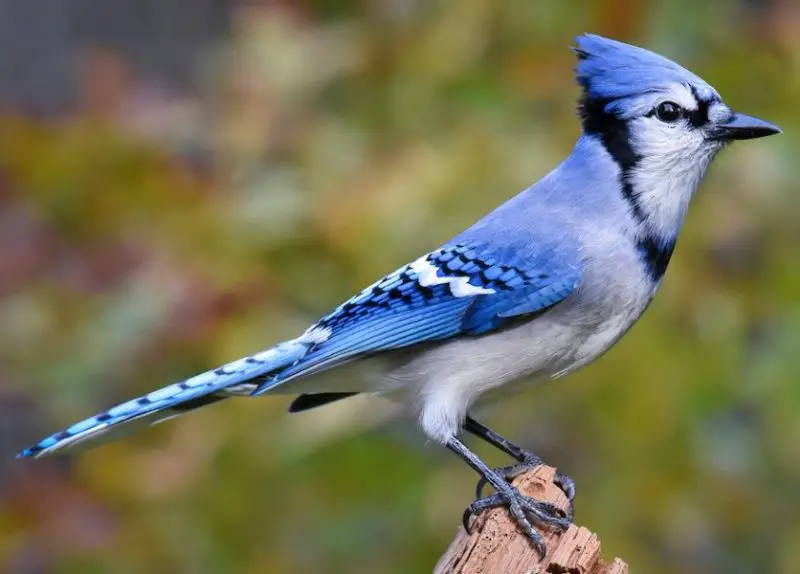
The Blue Jay is a bold, medium-sized bird recognizable by its brilliant blue plumage with white and black markings on its wings and tail. Its crest and distinctive “jay jay” call make it one of the most easily identified birds in Michigan. Blue Jays are highly intelligent and social birds.
They have a complex pattern of colors, including a bright blue back, white underparts, and black accents around the neck and face. Adults measure around 9 to 12 inches (23–30 cm) in length. Their strong, curved beaks help them crack open nuts and seeds, which are staples in their diet.
Blue Jays inhabit forests, woodlots, and suburban neighborhoods in Michigan. They are known to cache food for winter and sometimes mimic the calls of hawks to deter predators. Their loud calls and curious behavior make them a familiar presence year-round.
Indigo Bunting
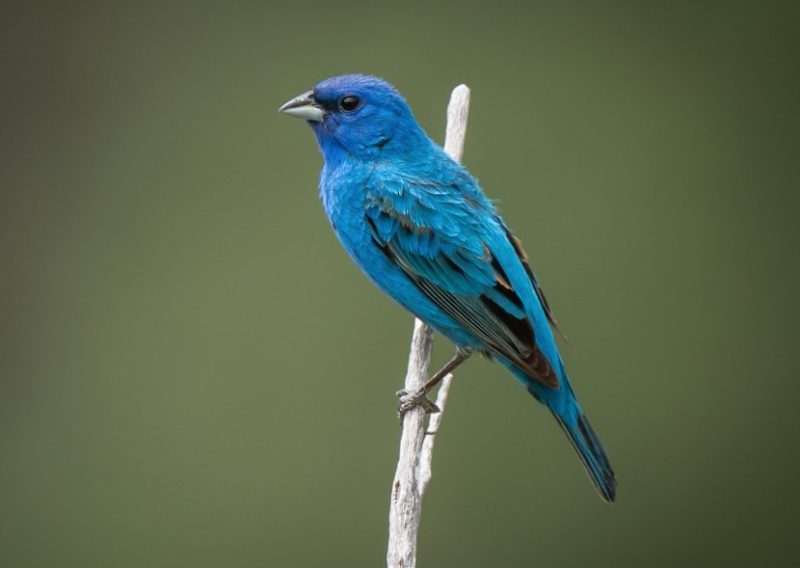
The Indigo Bunting is a small songbird famous for its brilliant, almost electric blue feathers in males during the breeding season. Females and juveniles tend to be brownish with subtle blue tinges. These birds are common in Michigan from late spring through summer, favoring open woodlands and brushy edges.
Male Indigo Buntings are especially striking with their vibrant blue plumage that helps them attract mates. They have a short, conical bill suitable for eating seeds and insects. Their song is a sweet, high-pitched warble that fills the summer air.
In Michigan, Indigo Buntings breed in shrubby fields, forest edges, and gardens. They are migratory, spending winters in Central and South America, and return north each spring. Birdwatchers often spot them perched conspicuously in sunlit areas.
Tree Swallow
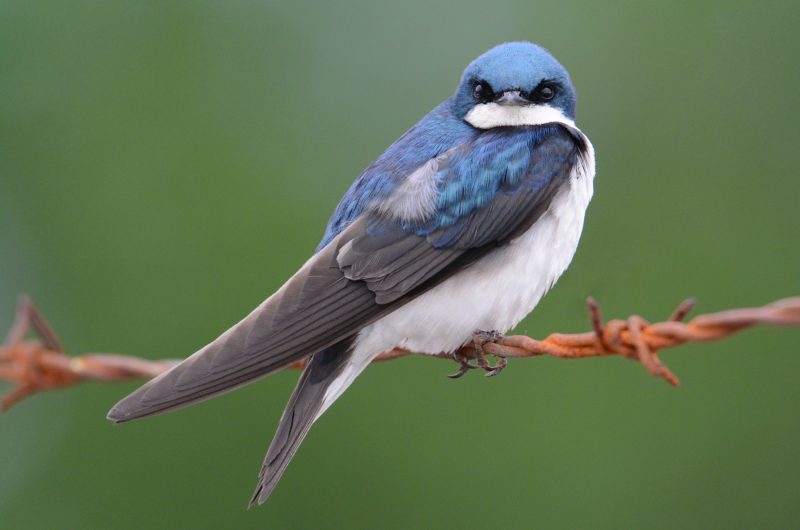
The Tree Swallow is a sleek, agile bird with iridescent blue-green upperparts and a clean white underside. It is commonly seen in Michigan during the warmer months as it breeds near ponds, marshes, and open fields. Tree Swallows are excellent fliers and often catch insects mid-air.
Their shimmering blue coloration can appear almost metallic in sunlight. They measure about 5.5 to 6.3 inches (14–16 cm) in length and have pointed wings and a slightly forked tail that aid their acrobatic flight. Both males and females share similar coloring, though females are sometimes duller.
Tree Swallows nest in tree cavities or nest boxes and are one of the earliest migrants returning to Michigan in spring. They feed primarily on flying insects and are often seen swooping gracefully over water bodies and fields.
Cerulean Warbler

The Cerulean Warbler is a small songbird prized for its soft, sky-blue coloration on the male’s upperparts contrasted with white underparts. This species breeds in mature deciduous forests in Michigan during the summer. Its delicate and sweet song is a hallmark of springtime in wooded areas.
Male Cerulean Warblers show bright cerulean-blue backs and heads with black streaks on the wings, while females have a more muted blue-gray tone. They are relatively small, measuring about 4.3 to 5.1 inches (11–13 cm) in length. Their slim build helps them flit quickly through the forest canopy.
In Michigan, Cerulean Warblers prefer large tracts of mature forest, often high in the canopy. Due to habitat loss, they are considered a species of conservation concern, making sightings especially exciting for birdwatchers during their brief breeding season.
Blue Grosbeak
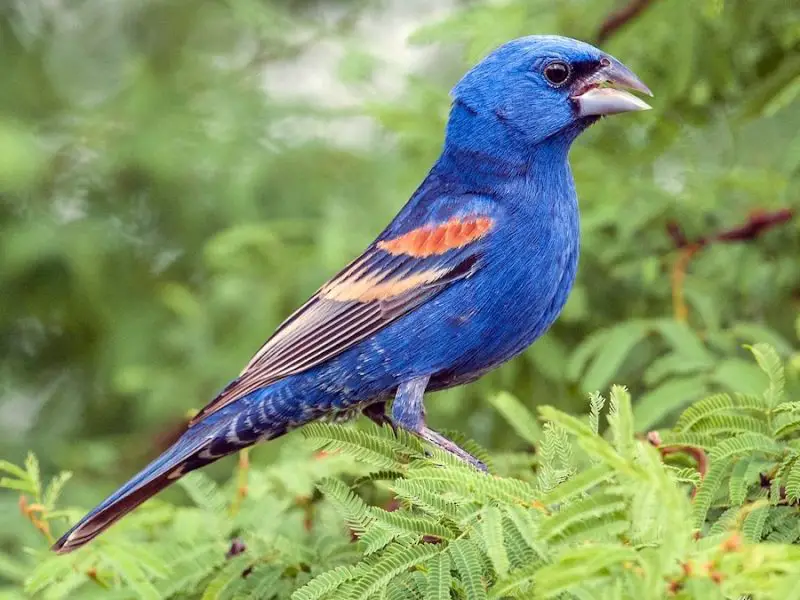
The Blue Grosbeak is a robust, stocky bird with deep blue plumage covering the male’s body, accented by two bold rusty wing bars. They are often found in Michigan’s shrubby areas and edges of woodlands from late spring through summer.
Males display a rich, almost cobalt blue color with bright chestnut wing patches, while females have a more subdued brownish tone with some blue hints. They measure about 6.3 to 7.5 inches (16–19 cm) long. Their strong, conical bill is well adapted for cracking seeds.
Blue Grosbeaks feed on seeds and insects and are known for their loud, buzzing songs. In Michigan, they nest in dense brushy areas, making them somewhat secretive but rewarding to find during the breeding season.
Belted Kingfisher

The Belted Kingfisher is a striking bird with slate-blue upperparts and a white belly, distinguished by its shaggy crest and large head. It is commonly seen near lakes, rivers, and wetlands in Michigan, where it hunts for fish.
Males have a blue-gray breast band, while females show an additional rusty band below the blue one. Adults measure about 11 inches (28 cm) in length. Their large bill helps them catch fish by diving from perches into the water below.
In Michigan, Belted Kingfishers nest in burrows dug into riverbanks or sandy banks. They are often spotted perched near water, waiting patiently before plunging to catch small fish, making them a favorite among bird enthusiasts.
Black-throated Blue Warbler
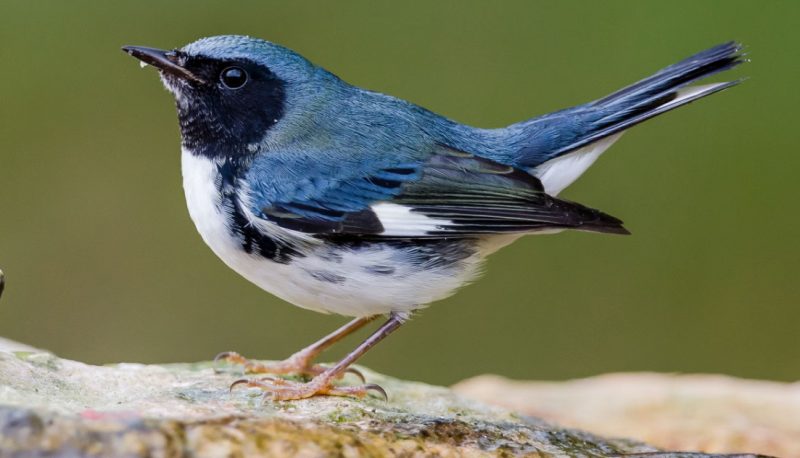
The Black-throated Blue Warbler is a small, striking songbird with deep blue upperparts and a contrasting black throat patch in males. Females are more subdued, showing olive-green backs and pale underparts. This species breeds in Michigan’s mixed and deciduous forests during the summer months.
Males are easily identified by their bright blue head and back, combined with a solid black face and throat. They measure about 4.3 to 5.1 inches (11–13 cm) in length, with a compact body and sharp bill suited for insect hunting. Their song is a rich, buzzy trill often heard in the forest understory.
In Michigan, Black-throated Blue Warblers prefer mature forest habitats with dense shrubs and a healthy canopy. They feed primarily on insects and spiders and are migratory, spending winters in the Caribbean and Central America. Sightings during migration seasons are treasured by birders.
Blue-gray Gnatcatcher
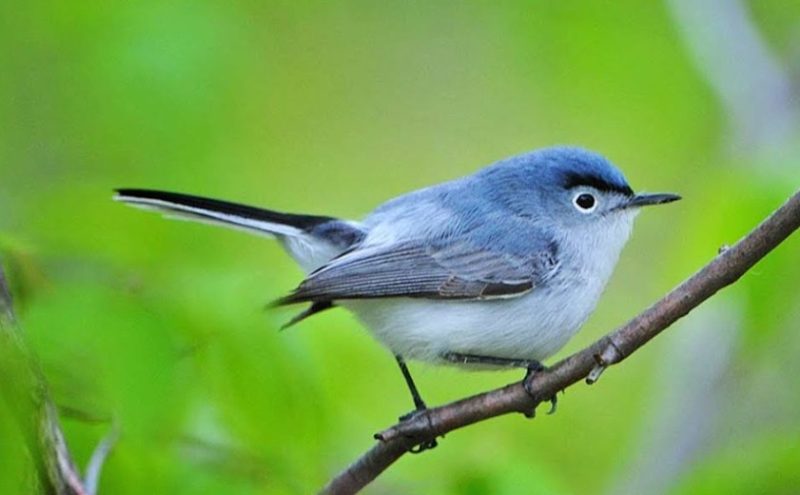
The Blue-gray Gnatcatcher is a tiny, active bird with soft blue-gray plumage and a distinctive long tail edged in white. It is a common sight in Michigan’s woodlands and shrublands from spring through fall. Their sharp, high-pitched calls and quick movements make them charming but sometimes tricky to spot.
Measuring only about 4 to 5 inches (10–13 cm) long, this bird has a slender body and a thin, pointed bill ideal for gleaning tiny insects and spiders from foliage. Males and females look similar, with subtle differences in coloration during breeding season.
Blue-gray Gnatcatchers nest in delicate cup-shaped nests woven in tree branches. They are highly agile foragers, flitting rapidly among leaves in search of prey. Their presence indicates a healthy insect population in Michigan’s forests and parks.
Purple Martin
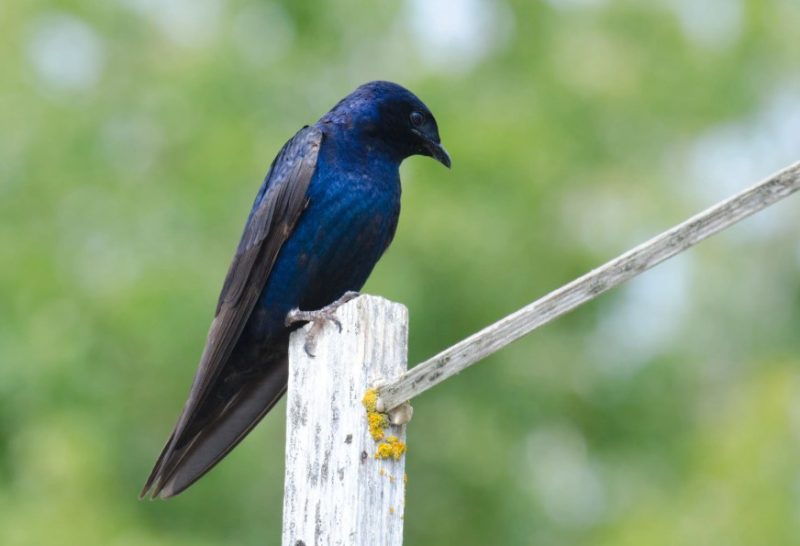
The Purple Martin is the largest North American swallow, known for its glossy iridescent plumage that shines with deep blue-purple hues in sunlight. In Michigan, Purple Martins arrive in spring to breed in colonies, often nesting in man-made houses or gourds provided by people.
Adults measure about 7 to 8 inches (18–20 cm) long and have a streamlined body with long, pointed wings built for agile flight. Males are darker and glossier than females, which are grayer underneath.
Purple Martins feed almost exclusively on flying insects caught on the wing. Their aerial acrobatics and cheerful chortling calls make them a favorite among birdwatchers. They are highly social birds and rely heavily on human-provided nesting sites in Michigan.
Northern Parula

The Northern Parula is a small, colorful warbler with bluish-gray upperparts, a yellow throat and chest, and a greenish patch on its back. A thin white eye ring and bluish wing bars help distinguish it from other warblers. Males also display a subtle chestnut band across the upper chest during the breeding season.
This species measures around 4.3 inches (11 cm) in length and has a quick, buzzy trill that’s often heard before the bird is seen. They are highly active, foraging among tree canopies for insects and spiders. Despite their bright colors, they can be hard to spot due to their preference for dense foliage.
In Michigan, Northern Parulas breed in mature, moist forests, especially those with hanging lichens like old man’s beard. They are more commonly found in the Upper Peninsula and northern Lower Peninsula during spring and summer. Birders often find them in areas near rivers, swamps, or mixed hardwood forests.
Blue-gray Gnatcatcher

The Blue-gray Gnatcatcher is a tiny, active bird with soft blue-gray plumage, a white eye ring, and a long black-and-white tail that often flicks side to side. Its slender body and quick movements give it an almost restless energy as it darts through branches in search of insects.
Measuring about 4 to 5 inches (10–13 cm) in length, this bird has a thin, pointed bill ideal for catching small insects and spiders. Males may show a faint black line above the eye during the breeding season, giving them a slightly more expressive face.
In Michigan, Blue-gray Gnatcatchers are common from spring through early fall. They prefer open woodlands, forest edges, and shrubby areas near water. Their high-pitched, nasal calls and active foraging behavior make them easy to detect even when hidden among dense foliage.
Green Heron
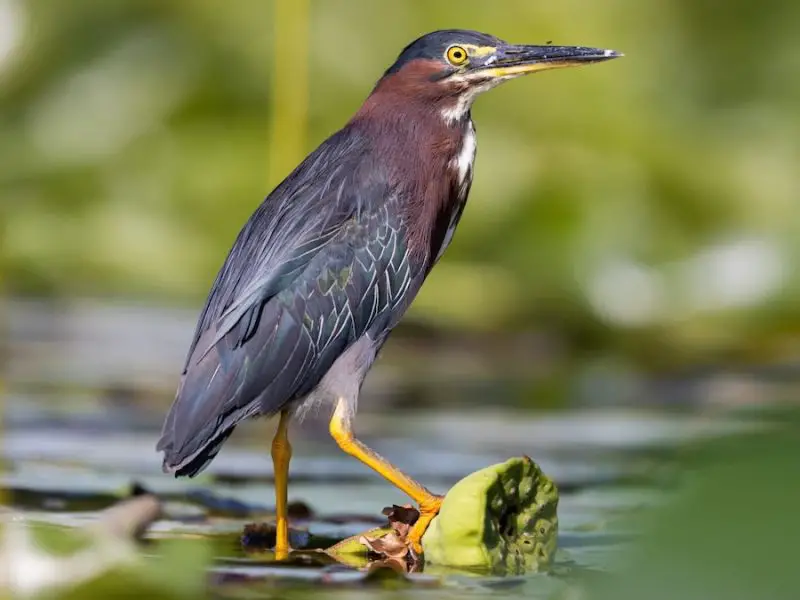
The Green Heron is a small, stocky wading bird with a striking appearance—dark greenish-black cap, rich chestnut neck and chest, and deep greenish-blue wings. Despite its name, the bird’s “green” can sometimes appear more bluish in sunlight, giving it a subtle iridescence. It often appears hunched with its neck tucked in.
Adults measure around 16 to 18 inches (41–46 cm) long and have relatively short legs compared to other herons. They are known for their patience and stealth, standing still for long periods before striking swiftly to catch fish or amphibians. Uniquely, Green Herons have been observed using tools, such as dropping insects or feathers on the water to lure prey.
In Michigan, Green Herons are typically found near marshes, streams, ponds, and the edges of lakes from spring through late summer. They prefer quiet, vegetated waters and are often spotted perched low on branches or walking slowly along the water’s edge. Their croaking call often gives away their location before they’re seen.
Eastern Blue-winged Teal
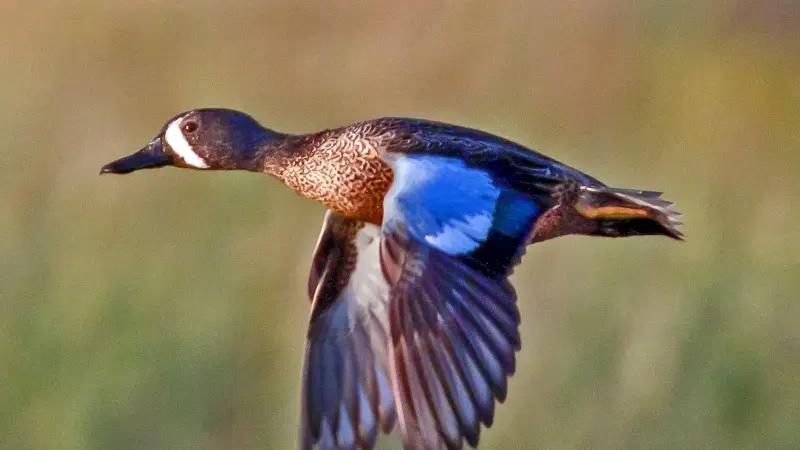
The Eastern Blue-winged Teal is a small dabbling duck with striking blue patches on its wings visible during flight. Males have a grayish-brown body with a distinctive white crescent in front of the eyes, while females are mottled brown and less colorful. This species frequents Michigan’s wetlands and marshes during migration and breeding seasons.
Measuring about 15 inches (38 cm) in length, Blue-winged Teals have compact bodies and short necks suited for quick dives and agile swimming. Their diet includes aquatic insects, seeds, and plants found in shallow waters.
In Michigan, they nest near marshes, ponds, and shallow lakes, often blending into dense vegetation for protection. Their high-pitched whistle calls and bright wing patches make them noticeable during migration flights.
FAQs About Blue Birds in Michigan
What are some common blue birds found in Michigan?
Michigan is home to a variety of blue birds, including the Eastern Bluebird, Blue Jay, Indigo Bunting, Tree Swallow, and Mountain Bluebird. Each species has distinct colors and behaviors that make them unique.
When is the best time to see blue birds in Michigan?
The best time to observe blue birds in Michigan is during the spring and summer months when most species are breeding and actively foraging. Migration periods in early spring and fall also offer chances to spot certain species.
Where do blue birds typically live in Michigan?
Blue birds inhabit diverse habitats such as open woodlands, meadows, wetlands, and suburban areas. For example, Eastern Bluebirds prefer open fields with scattered trees, while Tree Swallows are often found near water bodies.
How can I attract blue birds to my backyard?
To attract blue birds, provide native plants, fresh water, and appropriate bird feeders. Nest boxes designed for species like Eastern Bluebirds and Purple Martins can encourage breeding in your yard.
Do blue birds migrate away from Michigan in winter?
Some blue birds, like the Eastern Bluebird, may stay in Michigan during mild winters, but many species migrate south to warmer areas. Tree Swallows and Indigo Buntings, for example, are typically migratory.
What do blue birds eat?
Blue birds have varied diets depending on the species but generally include insects, seeds, berries, and small fruits. For instance, Blue Jays eat nuts and seeds, while Tree Swallows catch flying insects.
Are any blue birds in Michigan threatened or endangered?
Certain species, like the Cerulean Warbler and Piping Plover, face habitat loss and population declines and are considered of conservation concern. Protecting habitats and supporting conservation efforts helps these birds thrive.
How can I identify different blue warbler species?
Look for differences in size, wing and throat markings, and song. For example, the Black-throated Blue Warbler has a distinctive black throat patch, while the Blue-winged Warbler has bright yellow underparts with blue-gray wings.
Do blue birds have any cultural or symbolic significance?
Blue birds often symbolize happiness, hope, and renewal in many cultures. Their bright colors and joyful songs have inspired folklore, poetry, and art around the world.
Can I hear blue birds singing in Michigan?
Yes, many blue bird species have distinctive and melodious songs. For instance, the Eastern Bluebird’s soft warble and the Purple Martin’s chortling calls are commonly heard during the breeding season.



